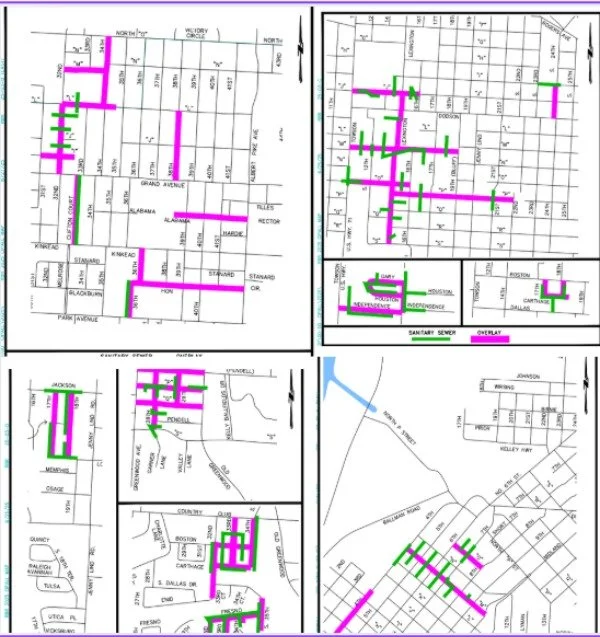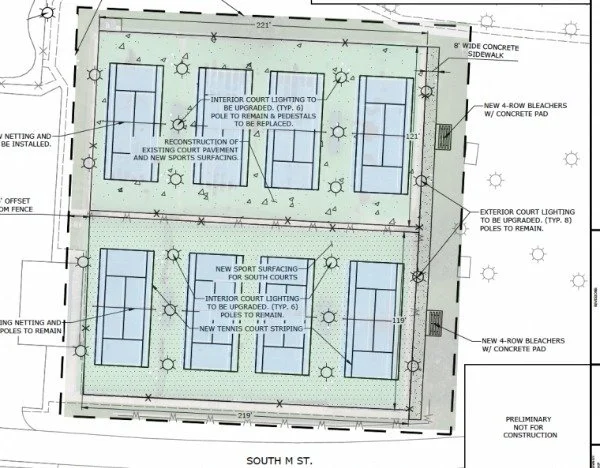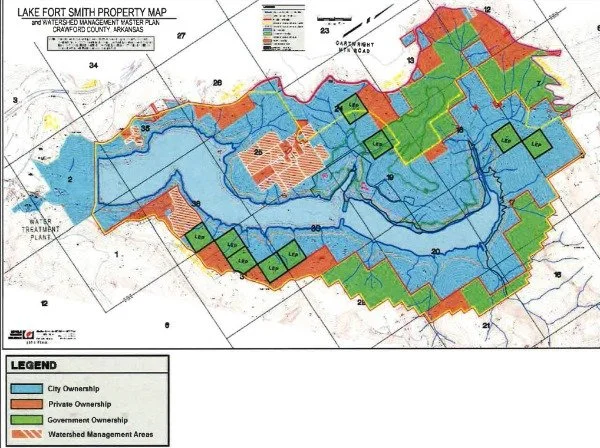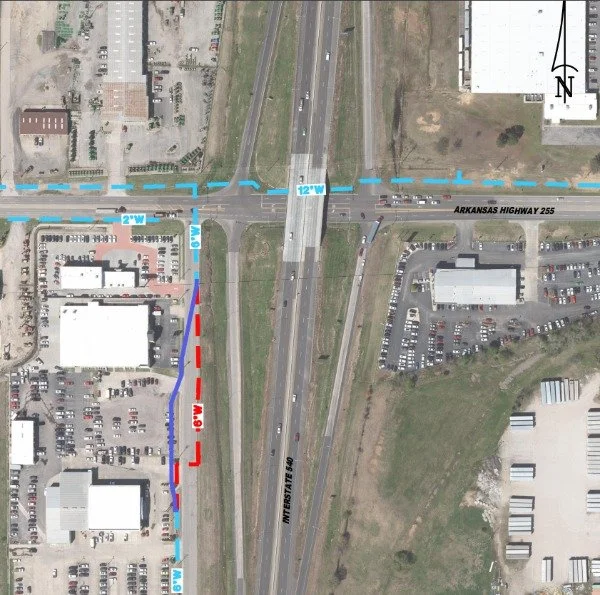Highlights of the Fort Smith Board of Directors Meeting 7/22/25
At the Fort Smith Board of Directors meeting scheduled for 7-22-25, the Board voted to approve and submit to the EPA the Energy and Environment Comprehensive Action Plan that is required to be crafted and submitted to the federal government by 8-1-25 as a part of the requirements for the Climate Pollution Reduction Grants. The City was already awarded and has accepted $14.5 million for sustainability projects including the alleyway rehabilitation project , workforce development, solar power for Nelson Hall Homes, and electric vehicle charging infrastructure.
Other recommendations mentioned in the plan for possible future consideration include
Incremental investment in sidewalks, bike lanes, and transit shelters
Pilot programs and public-private partnerships to test low cost scalable mobility solutions
Pursuit of State and Federal grants to fund improvements instead of City funds
Green infrastructure like rain gardens, bioswales, and permeable pavements
Stormwater reuse systems
Asset management tools to prioritize upgrades for extreme weather
Community led waste reduction initiatives
public-private partnerships to expand recycling, composting, and diversion of organic waste from the landfill
Grant funding for pilot programs for circular economy programs
Conservation easements to preserve open space
Volunteer programs to maintain trails and green spaces
Low impact design standards for new developments near natural areas
Encouraging regional collaboration
Prioritizing positive social impact
Monitoring progress, evaluating effectiveness, and adjusting strategies to respond to challenges and opportunities
Monitoring projects and evaluating outcomes to assure transparency and accountability
Updating Greenhouse Gas (GHG) emissions inventory regularly
Conducting a carbon sequestration inventory
Conducting a carbon storage study
31% of the Fort Smith region’s GHG emissions are related to the electrical power sectors. Some potential future projects suggested in the plan related to electrical power include
Priority Project *- Remediation of brownfield sites for conversion for renewable energy infrastructure
Expansion of renewable energy for City operations
Repairs/improvements to the Clyde T. Ellis Hydroelectric generating station
Supporting/incentivising renewable energy with priority given to disadvantaged communities
Identifying opportunities to rescue capacity demand for water treatment facilities by reducing stormwater infiltration and potable water demand
31% of the Fort Smith region’s GHG emissions are related to transportation. Some potential future projects suggested in the plan related to transportation include
Priority Project*- Implementation/Expansion of smart intersections that use technology to enhance efficiency and reduce traffic congestion
Priority Project*- Remediation of brownfield sites for conversion for support of active transportation
Expansion of public transit with more service hours and larger service area
Replacing City vehicles with low/no emission vehicles
Expanding infrastructure for alternative fuel vehicles including bus fleets
Expanding infrastructure for active transportation including sidewalks, trails, bicycle facilities, and transit stops with priority given to disadvantaged communities
Developing low/no emission ride sharing and e-bike programs with priority given to disadvantaged communities
Updating building and zoning codes to encourage walkable, bikeable, and transit-friendly development
8% of GHG emissions in the Fort Smith region are related to buildings. Some potential future projects suggested in the plan related to buildings include
Priority Project*-Providing educational resources about opportunities to use the Commercial Property Assessed Clean Energy finance mechanism that allows commercial property to finance sustainability and efficiency improvements
Priority Project*- Remediation of brownfield sites for conversion to support workforce development related to building energy efficiency improvements
Upgrading municipal facilities for energy efficiency
Adopting up to date building energy codes
Developing voluntary programs to promote low emission transportation options and electric vehicle charging focused on buildings in disadvantaged communities, multi-family residential buildings, and commercial buildings
9% of GHG emissions in the Fort Smith region are related to the industrial sector. Some potential future projects suggested in the plan related to industry include
Priority Project*- Remediation of brownfield sites into educational facilities for workforce development for industrial efficiency
Efficiency upgrades for the Port of Fort Smith
Programs to support energy efficiency for local industry
Some potential future projects suggested in the plan related to solid waste include
Priority Project*- Remediation of brownfield sites for conversion to recyclable material facilities
Building a City operated recyclable materials recovery facility
Constructing an anaerobic digester facility at the wastewater treatment plant
Construction of a biomass gasification facility or biochar pyrolysis facility at the landfill
Some potential future projects suggested in the plan related to carbon sequestration include
Priority Project*- Remediation of brownfield sites into parks and urban forests
Priority Project*-Planting native trees and plants in City owned parks, trails, and rights of way
Identifying green land for protection by means including purchase and conservation easements
Restoring prairies, forests, streams, and wetlands on City properties
Developing conservation plans for new parks that include measures to preserve areas with high carbon sequestration value
The plan suggests future potential partnerships with UAFS, Peak Innovation Center, Fort Smith Public Schools, and the Arkansas Advanced Energy Foundation for workforce development projects for green careers and education related to energy efficiency.
Rick Murphy spoke in support of the plan. He praised Sustainability Officer Robertson’s work on crafting the plan. He expressed support for how comprehensive the plan is and its aims to ensure safe drinking water, clean air, and walkable streets.
Jo Elsken spoke in support of the plan. She mentioned the workforce development parts of the plan helping Fort Smith to compete with other cities in Arkansas. She said that nothing will be spent by approving the plan and that approval “just says that you care” about the environment and the future of the City.
Director Rego thanked all of the community members involved in the community meetings and who responded to the survey and who put in other efforts for their engagement and efforts in developing the plan.
Director Martin voiced his concerns about the plan “because it is so broad.” He said “From a cost perspective, we’re blowing this thing out of the water.” He expressed concerns about changes to the building and zoning codes making housing more expensive and concerns about “overreach.”
Director Kemp asked if the plan costs the City money. Robertson answered that just approving the plan will not cost anything. He said that the plan sets up support for state and federal funding opportunities. Director Kemp asked if the plan makes any changes to building codes. Robertson said that it does not. Director Kemp asked if it the Planning Commission and Board vote process would still be required to make any building code changes. Robertson confirmed that it would. Director Kemp asked about the parts of the plan pertaining to brownfields. Robertson said that the EPA recently released grants for brownfields and the current federal administration potentially poses opportunities for grant funding for brownfields so they were mentioned specifically in the plan. Director Kemp asked if the plan had been vetted by the new federal administration. Robertson said it had been reviewed by the new EPA and had passed. Director Kemp said it is “our job as elected leaders to bring federal dollars home every chance we get.”
The Board voted to approve the plan and submit the plan to the EPA with only Directors Settle and Martin voting against approval and Director George Catsavis abstaining from voting.
The Board voted unanimously to raise the City pay rate for engineers. The pay increases were suggested to be able to offer pay rates that are competitive enough to improve hiring and retention of skilled engineers. Acting City Administrator Dingman said that there is a “problem attracting project engineers.”
The Board voted unanimously to contract with Hawkins-Weir for $291,250, Brixley for $402,000, and Mickle Griffin for $535,460 for engineering services for streets resurfacing projects and sewer work to be done at the same time.
Director Settle praised the collaboration between Streets and Utilities saying doing both at the same time is a “great idea.”
The Board voted unanimously to adopt the formal grants policy. The policy aims to be a policy in which official standardized processes and procedures will be applied consistently by all departments and will comply with all state, local, and federal regulations. The policy voted on was the one discussed at the 6-10-25 study session meeting with the addition of a section regarding the role of Internal Audit, a section regarding the Transit Department, and a section regarding the Community Development Department.
The Board voted unanimously to apply for an Arkansas Community Assistance Grant for resurfacing of the top 4 tennis courts at Creekmore, reconstruction of the bottom 4 courts with a base of concrete instead of asphalt, replacement of fencing and windscreens, adding spectator seating on the east side of the courts, and conversion to LED light fixtures. The entire project would cost $1,117,000 but with the State grant covering 80% of the project the City’s required 20% contribution would only be $223,4000.
The Board voted unanimously to approve a settlement agreement in the employment discrimination case of former City employee Asentha Saul. The settlement will result in the City paying Saul $9500. She will be responsible for her own legal and court fees. If the case had gone to trial, Saul was seeking a total of $300,000-$350,000. Plus, regardless of if the City were to have won or lost the case, the cost of going to trial for City legal fees, staff wages, and other costs would have been about $40,000. The settlement agreement amount is less than 25% of the costs that would be incurred if the case went to trial even if the City won at trial.
Director George Catsavis asked what the suit was over. Dingman said that Saul was fired 2 years ago for poor job performance and filed a suit for discrimination and accommodation issues.
Acting Human Resources Director Garvin said that in addition to the lawsuit Saul filed a claim with the Equal Employment Opportunity Commission (EEOC). Director Christina Catsavis mentioned that the EEOC declined that complaint. Garvin confirmed that.
Director Christina Catsavis said after seeing the item on the agenda that she discovered via an internet search a news article published in February about the case. She said that the issue is one to “add to the pile of things the Board has never been made aware of.” She also expressed concerns that paying a settlement would set a precedent that might might result in more people who get fired for performance issues deciding to sue the City.
The Board voted unanimously to exchange land with the US Forest Service around Lake Fort Smith. The swap will be an even land-for-land swap and will not result in any cost for either the City or the Forest Service.
The Board discussed contracting with Amaresco for $125,000 for an investment grade audit to analyse the existing water meter database focusing on meter consumption, sizes, and type of meters and to evaluate potential effects of system rehabilitation and automation and determine potential operational cost savings. The project would take 3-5 months to complete.
Director Christina Catsavis asked how Ameresco came to the City. Utilities Director McAvoy answered that they came through a Request for Proposals process. Director Christina Catsavis asked how many companies submitted responses. McAvoy answered that there were 4. Director Christina Catsavis said that the last new water meter system installed did not meet the promised outcome. McAvoy agreed and said that a study of the type to be done by Amaresco should have been done prior to that last meter change out. Director Christina Catsavis said that because Amaresco stands to profit from doing the work if the City decides to move forward with Phase 2, installing new meters, that the audit is “more like a sales pitch than a true audit.” She said that new meters would be “one of the the largest capital undertakings our city’s history.” She suggested that instead the City go back to doing manual meter readings.
McAvoy said that meters are currently beginning to fail and that something will have to be done other than just going back to manual readings. He mentioned that currently the City writes off over a million dollars per year in leak adjustments and that with an AMI meter system the customers could be notified about leaks sooner instead of requiring such large write-offs. He said that the study would “find the best fit system for us.”
Director Christina Catsavis wondered aloud “What about 5 years from now?” as technology changes and said that the City can’t keep “jumping on every band wagon.” McAvoy said that if the City does opt to move on to installing the new meters that Ameresco guarantees that the City will see additional revenue generated and said if Fort Smith do not see that Amaresco are “on the hook for making that up to Fort Smith.” Director Christina Catsavis requested that the Board be provided with a list of different styles of meters and prices for those meters before the next meeting.
Director Kemp asked if the meter replacement would help prevent rate increases. McAvoy said “I think it would.” He mentioned additional revenue from meters that under read and result in under billing and also reduced loss in revenue from water leak write-offs. Director Kemp asked about using Audit Department funds instead of Utilities Department funds to pay for the study. Director Christina Catsavis said that she wouldn’t call it a “true audit.” Dingman said that it being considered a Utilities expense would be “more appropriate.”
Director Christina Catsavis mentioned that even if the City chooses not to move forward with Phase 2, the City would still be out $125,000 for the study.
Director Settle said that he would rather that the City spend that $125,000 on brand new meters. He suggested that the City deal with the issue in-house instead of involving an outside company. He said “We already know what the audit’s gonna tell us.” He suggested instead that the City just gradually change out meters themselves.
Director Martin asked what percentage of unaccounted for water loss is likely before the meters and what percentage is likely after. McAvoy said that of the 35% total unaccounted for water loss, 10-15% loss is from inaccurate meters and 20-25% loss is on the City side of the meters. He said that 20% is considered “good” for a system the age of Fort Smith’s, but that they “shoot for 15%.”
Charles Nobles from Amaresco said “We are not sharing in any of the revenue.” He said that Amaresco stands to make money off the construction to install the meters and that they lose money on the audit. He said that they are “vendor agnostic” as far as the meters are concerned. He said that the audit would involve bringing in 200 new meters for sampling and field testing about 400 large meters (all of the meters over 3 inches) that cannot be tested on a test bench but must be tested in place instead. The testing is sent out to a third party lab, not done by Ameresco themselves.
Director Kemp said that the study would provide “real data” to the Board.
Director Christina Catsavis asked if the City could do it themselves and send the testing out to a third party lab themselves. Dingman said that they could not because the large meters have to be tested in place. McAvoy said that the City does not have the equipment or staff trained to do that.
Director Settle motioned to table the issue to the second meeting August. The Board voted to table the issue with all except Directors Rego, Good, and Kemp voting to table.
The Board voted unanimously to contract with Goodwin & Goodwin for $370,325.75 for a water line relocation project at the I540 exit ramp and Zero Street intersection needed in relation to an ARDOT road project. The entire cost of the project will be reimbursed by ARDOT.
In Executive Session, the Board interviewed one applicant, Jason Mitchell, for the Director of Internal Audit vacancy. No action was taken regarding that interview.
The Board reappointed Larry Combs to the Port Authority and appointed Pete Hanham to the Property Owners Appeal Board. No action was taken regarding making an appointment for a vacancy on the Historic District Commission.










